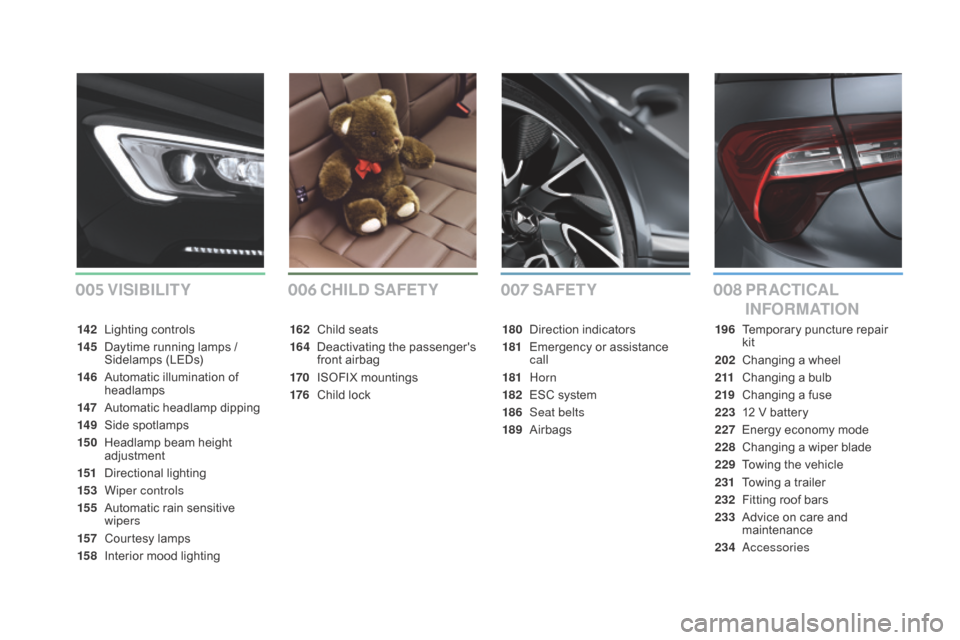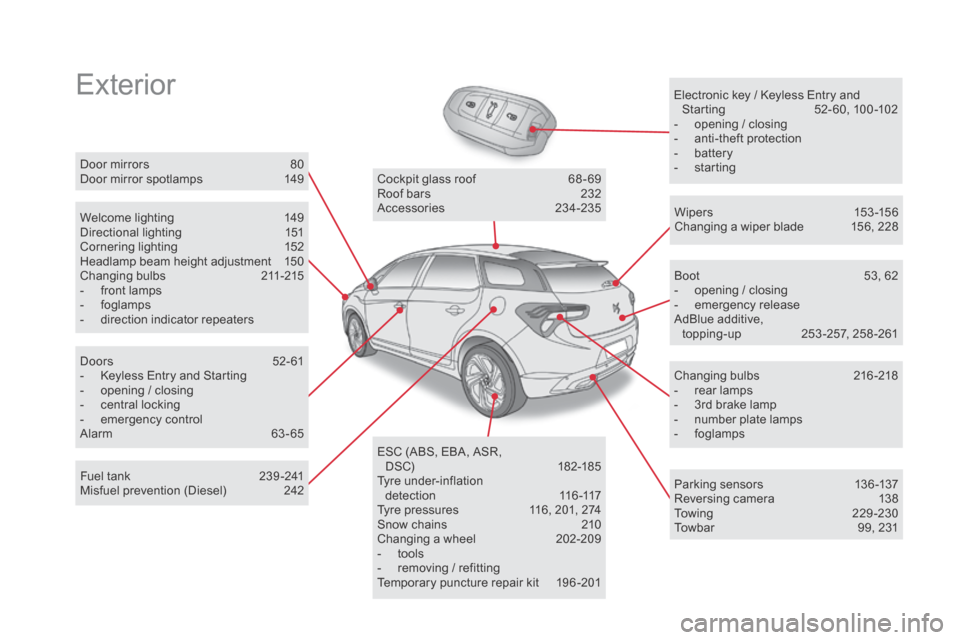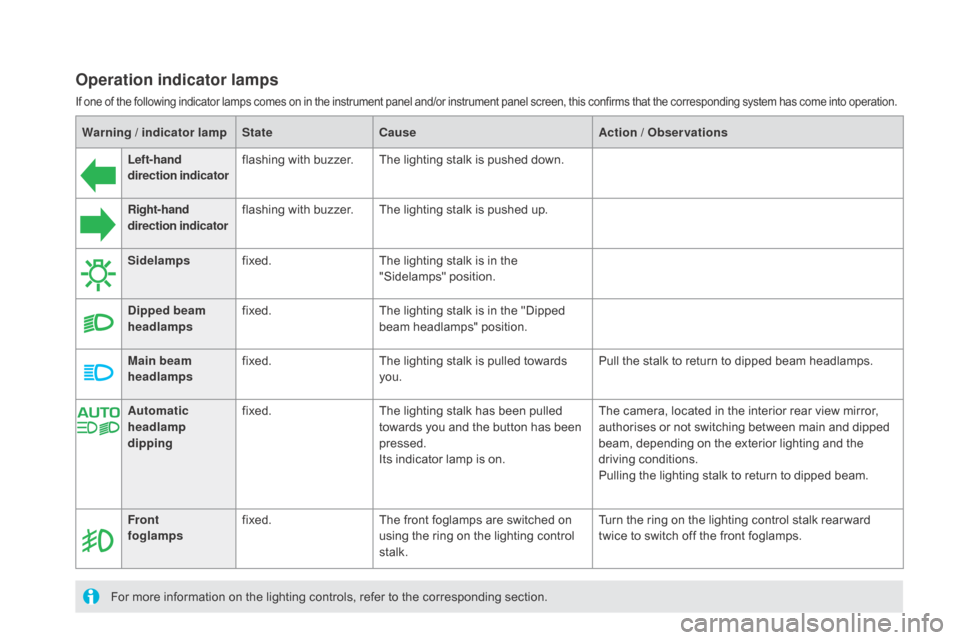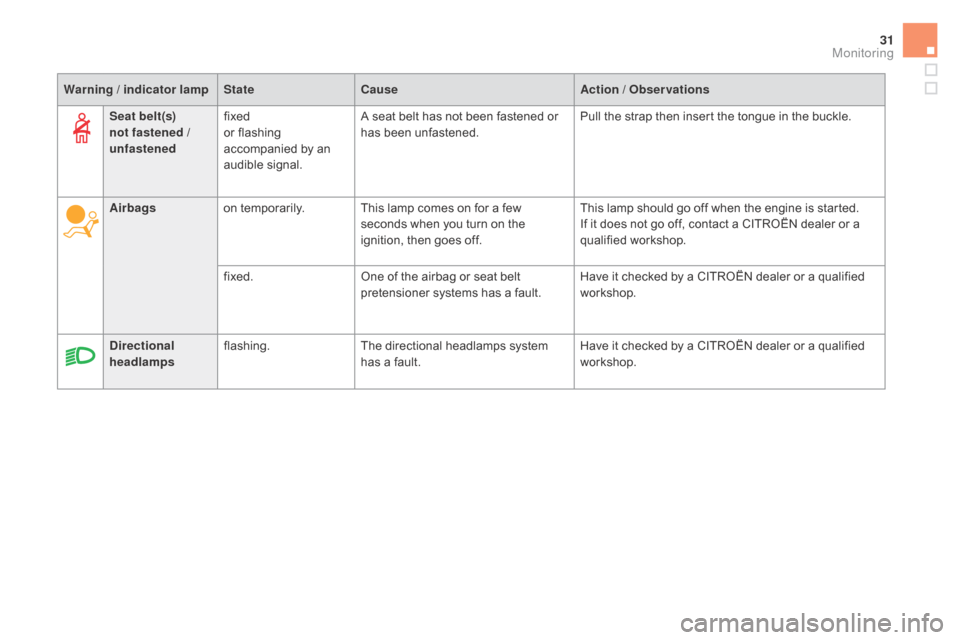headlamp Citroen DS5 HYBRID4 2015.5 1.G Owner's Manual
[x] Cancel search | Manufacturer: CITROEN, Model Year: 2015.5, Model line: DS5 HYBRID4, Model: Citroen DS5 HYBRID4 2015.5 1.GPages: 400, PDF Size: 23.96 MB
Page 6 of 400

005006007008SAFETY PR A cT IcA L
I
nF
ORMATIO
n
c
HILd S
AFETY
VISIBILITY
142 Lighting controls
14 5
D
aytime running lamps /
Sidelamps (LEDs)
14 6
A
utomatic illumination of
headlamps
147
A
utomatic headlamp dipping
14 9
S
ide spotlamps
15 0
H
eadlamp beam height
adjustment
151
D
irectional lighting
153
W
iper controls
155
A
utomatic rain sensitive
wipers
157
C
ourtesy lamps
15 8
I
nterior mood lighting 162 C
hild seats
164
D
eactivating the passenger's
front airbag
170
I
SOFIX mountings
176
C
hild lock180 D
irection indicators
181
E
mergency or assistance
call
181
H
orn
182
ES
C system
186
Se
at belts
189
A
irbags196 T
emporary puncture repair
kit
202
C
hanging a wheel
2 11
C
hanging a bulb
219
C
hanging a fuse
223
1
2 V battery
227
E
nergy economy mode
228
C
hanging a wiper blade
229
T
owing the vehicle
231
T
owing a trailer
232
F
itting roof bars
233
A
dvice on care and
maintenance
234
Accessories
Page 10 of 400

ExteriorElectronic key / Keyless Entry and Starting 5 2- 60, 100 -102
-
o
pening / closing
-
a
nti-theft protection
-
b
attery
-
s
tarting
Welcome lighting
1
49
Directional lighting
1
51
Cornering lighting
1
52
Headlamp beam height adjustment
1
50
Changing bulbs
2
11-215
-
f
ront lamps
-
fo
glamps
-
d
irection indicator repeaters Wipers
15
3 -15 6
Changing a wiper blade
1
56, 228
Doors
5
2- 61
-
K
eyless Entry and Starting
-
o
pening / closing
-
c
entral locking
-
em
ergency control
Alarm
6
3-65 Cockpit glass roof
6
8 - 69
Roof bars
2
32
Accessories
23
4-235
ESC (ABS, EBA, ASR, DSC)
18
2-185
Tyre under-inflation d e t e c t i o n
11
6 -117
Tyre pressures
1
16, 201, 274
Snow chains
2
10
Changing a wheel
2
02-209
-
t
ools
-
r
emoving / refitting
Temporary puncture repair kit
1
96 -201 Boot
5
3, 62
-
o
pening / closing
-
em
ergency release
AdBlue additive, topping-up
2
53 -257, 258 -261
Changing bulbs
2
16-218
-
r
ear lamps
-
3
rd brake lamp
-
n
umber plate lamps
-
fo
glamps
Door mirrors
8
0
Door mirror spotlamps
1
49
Fuel tank
2
39 -241
Misfuel prevention (Diesel)
2
42 Parking sensors
1
36 -137
Reversing camera
1
38
To w i n g
2
2 9 - 2 3 0
Towbar
9
9, 231
Page 14 of 400

Instruments and controls
Automatic headlamps 147-148
Lane departure warning system
1
22
Volumetric alarm monitoring
6
3-65
Electric windows, front /rear
6
6 - 67
Electric child lock
1
76
Central locking
6
1 Opening the fuel filler flap
2
39
Opening the boot
6
2
Parking sensors
1
36 -137
DSC/ASR systems
1
84-185
Stop & Start
1
18 -121
or
Blind spot sensors
1
23 -125
Side switch panel
Localised emergency call 1 81, 278 -279
Localised assistance call 1 81, 278 -279
Cockpit glass roof
6
8 - 69
Head-up display
1
26 -127
Door mirrors
8
0
Headlamp height adjustment
1
50
centre switch panel
Page 15 of 400

13
Maintenance - Technical data
Checking levels 247-250
- o il
-
b
rake fluid
-
p
ower steering fluid
-
c
oolant
-
s
creenwash/headlamp wash fluid
AdBlue additive
2
53 -261
Checking components
2
51-252
-
a
ir filter
-
p
assenger compartment filter
-
o
il filter
-
e
lectric parking brake
-
b
rake pads / discs
Changing bulbs
2
11-218
-
f
ront
-
r
ear Opening the bonnet
2
43
Under the bonnet, petrol
2
44
Under the bonnet, Diesel
2
45Dimensions
2
73
Identification markings
2
74
Running out of fuel (Diesel)
2
46
12V battery
2
23 -226
Load reduction, economy mode
2
27
Engine compartment
fuses
2
19 -220, 222
Petrol engines
2
64
Diesel engines
26
7-268
Petrol weights 2 65 -266
Diesel weights
2
69 -272
Over view
Page 16 of 400

Eco-driving
Eco-driving is a range of everyday practices that allow the motorist to optimise their fuel consumption and CO2 emissions.
Optimise the use of your gearbox
With a manual gearbox, move off gently and change up without waiting.
During acceleration change up early.
With an automatic gearbox, give preference to automatic mode and
avoid pressing the accelerator pedal heavily or suddenly.
The gear efficiency indicator invites you engage the most suitable gear:
as soon as the indication is displayed in the instrument panel, follow it
straight away.
For vehicles fitted with an automatic gearbox, this indicator appears
only in manual mode.
drive smoothly
Maintain a safe distance between vehicles, use engine braking rather
than the brake pedal, and press the accelerator progressively. These
practices contribute towards a reduction in fuel consumption and CO
2
emissions and also helps reduce the background traffic noise.
If your vehicle has cruise control, make use of the system at speeds
above 25 mph (40 km/h) when the traffic is flowing well.
control the use of your electrical
equipment
Before moving off, if the passenger compartment is too warm, ventilate it
by opening the windows and air vents before using the air conditioning.
Above 30 mph (50 km/h), close the windows and leave the air vents
open.
Remember to make use of equipment that can help keep the
temperature in the passenger compartment down (sunroof and window
blinds...).
Switch off the air conditioning, unless it has automatic regulation, as
soon as the desired temperature is attained.
Switch off the demisting and defrosting controls, if not automatic.
Switch off the heated seat as soon as possible.
Switch off the headlamps and front foglamps when the level of light
does not require their use.
Avoid running the engine before moving off, particularly in winter; your
vehicle will warm up much faster while driving.
As a passenger, if you avoid connecting your multimedia devices
(film, music, video game...), you will contribute towards limiting the
consumption of electrical energy, and so of fuel.
Disconnect your portable devices before leaving the vehicle.
Page 22 of 400

Warning / indicator lampStatecau seAction / Observations
Left-hand
direction indicato rflashing with buzzer.
The lighting stalk is pushed down.
Right-hand
direction indicator flashing with buzzer.
The lighting stalk is pushed up.
Sidelamps fixed. The lighting stalk is in the
"Sidelamps" position.
di
pped beam
headlamps fixed.
The lighting stalk is in the "Dipped
beam headlamps" position.
Main beam
headlamps fixed.
The lighting stalk is pulled towards
you. Pull the stalk to return to dipped beam headlamps.
Front
foglamps fixed.
The front foglamps are switched on
using the ring on the lighting control
stalk. Turn the ring on the lighting control stalk rear ward
twice to switch off the front foglamps.
For more information on the lighting controls, refer to the corresponding section. Automatic
headlamp
dipping
fixed.
The lighting stalk has been pulled
towards you and the button has been
pressed.
Its indicator lamp is on. The camera, located in the interior rear view mirror,
authorises or not switching between main and dipped
beam, depending on the exterior lighting and the
driving conditions.
Pulling the lighting stalk to return to dipped beam.
Operation indicator lamps
If one of the following indicator lamps comes on in the instrument panel and/or instrument panel screen, this confirms that the corresponding system has come into operation.
Page 33 of 400

31
Warning / indicator lampStatecau seAction / Observations
Airbags on temporarily. This lamp comes on for a few
seconds when you turn on the
ignition, then goes off. This lamp should go off when the engine is started.
If it does not go off, contact a CITROËN dealer or a
qualified workshop.
fixed. One of the airbag or seat belt
pretensioner systems has a fault. Have it checked by a CITROËN dealer or a qualified
workshop.
di
rectional
headlamps flashing.
The directional headlamps system
has a fault. Have it checked by a CITROËN dealer or a qualified
workshop.
Seat belt(s)
not fastened /
unfastened
fixed
or flashing
accompanied by an
audible signal. A seat belt has not been fastened or
has been unfastened.
Pull the strap then insert the tongue in the buckle.
Monitoring
Page 40 of 400

This allows some of the instrument panel
displays, as well as the touch screen, to be
switched off when driving at night, so as to
reduce visual fatigue for the driver.
The essential driving information, such as
the vehicle speed, warning lamps, the gear
engaged for an automatic gearbox, cruise
control or speed limiter, remains displayed in
the instrument panel.
Black panel (comfortable
night display) with the
touch screen
Clock
The analogue clock does not have an
adjustment button.
To set the time, refer to the section relating to
the screen (audio system) configuration menu.
The clock is synchronised with the screen time;
once the the setting has been confirmed in the
screen, the hands will turn to synchronise with
the screen, as well as every time the ignition is
switched on.
F
W
ith the exterior lighting on,
press this button to activate the
function.
Touch screen
You can return to the current display
at any time by by pressing the blank
screen or one of the menu buttons.
In automatic illumination of headlamps
mode, the "Black panel" function is
automatically deactivated once the
ambient light reaches an adequate
level.
F
P
ress this button again or press the
instrument panel lighting dimmer button to
deactivate the function.
Page 43 of 400

41
- "Driving assistance":● " Parking brake automatic" (Automatic
electric parking brake; see the "Driving"
section),
●
"
Rear wipe in reverse gear" (Rear
wiper coupled to reverse gear; see the
"Visibility" section),
●
"
Speeds memorised" (Memorising
speeds; see the "Driving" section).
-
"
Vehicle lighting" (see the " Visibility"
section):
●
"
Directional headlamps" (Main /
additional directional lighting),
-
"
Interior lighting" (see the " Visibility"
section):
●
"
Follow-me-home headlamps"
(Automatic operation of headlamps after
switching off the ignition),
●
"
Welcome lighting" (Exterior welcome
lighting),
●
"
Mood lighting" (Mood lighting). For example: setting of the duration of the
"follow-me-home" lighting
F
P
ress the "7" or " 8" buttons, to select the
"Define the vehicle parameters" menu,
then the " OK" button.
F
P
ress the "5" or " 6" buttons to select
the "Interior lighting" line, then the
"OK"
button; then follow the same
procedure to select the "Follow-me-home
headlamps" line. F
P ress the "7" or " 8" buttons to set the
value required (15, 30 or 60 seconds), then
press the "OK" button to confirm.
F
P
ress the "5" or " 6" buttons, then the
"OK" button to select the "OK" box and
confirm or press the "Back" button to
cancel.
Monitoring
Page 83 of 400

81
Automatic day/night model
By means of a sensor, which measures the
light from the rear of the vehicle, this system
automatically and progressively changes
between the day and night uses. Adjustable mirror providing a central rear ward
view.
Equipped with an anti-dazzle system, which
darkens the mirror glass and reduces the
nuisance to the driver caused by the sun,
headlamps from other vehicles...
Rear view mirror
In order to ensure optimum visibility
during your manoeuvres, the mirror
lightens automatically when reverse
gear is engaged.
Steering wheel adjustment
F When stationary, pull the control lever to
release the adjustment mechanism.
F
A
djust the height and reach to suit your
driving position.
F
P
ush the control lever to lock the
adjustment mechanism.
As a safety measure, these operations
should only be carried out with the
vehicle stationary.
Seeing clearly
For better rear vision, align the bottom of the
rear view mirror with the bottom of the rear
screen.
comfort